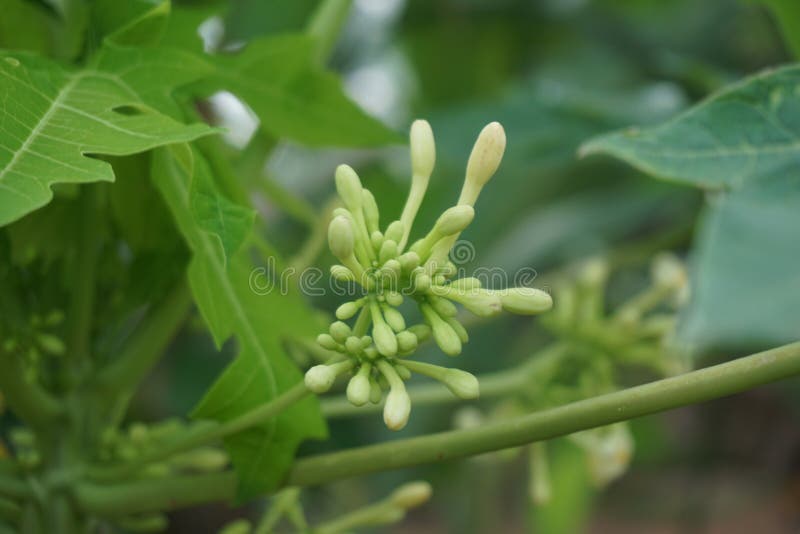
Have you ever planted a papaya seed with dreams of juicy, sweet fruit, only to be met with a tall, leafy tree that never seems to deliver? The world of papaya plants can be a bit tricky, and understanding the nuances between male, female, and hermaphrodite plants is key to a successful harvest. One common misconception is that male papaya trees never bear fruit. Let's dive into that myth and explore the fascinating reality of male papaya plants and their fruiting potential.
The Misunderstood Male Papaya Plant
The term "male papaya plant" often conjures images of unproductive trees, forever doomed to be pollen producers and nothing more. While it's true thatstrictlymale papaya plants, those with only male flowers, don't produce marketable fruit, the story is more complex than that. Understanding the different types of papaya plants is the first step to dispelling this myth.
Types of Papaya Plants: A Quick Overview
Papaya plants typically come in three forms:
- Female: These plants produce only female flowers, which require pollination to develop into fruit. Female flowers are easily identifiable by their large, single pistil (the female reproductive part) in the center. They are located close to the trunk of the tree, giving the papaya fruit a rounder shape.
- Male: True male papaya plants produce only male flowers. These flowers have long, slender stalks and contain only stamens (the male reproductive parts) and are less likely to produce papaya fruit.
- Hermaphrodite: These plants, also known as monoecious papayas, are the most common and desirable for fruit production. They possess both male and female reproductive organs within the same flower. This allows them to self-pollinate and produce fruit without the need for a separate male plant. Hermaphrodite flowers are somewhere in between the shapes of male and female flowers. The fruit from these plants are often elongated or pear-shaped.
So, Can Male Papaya Plants Bear Fruit?
Here's where things get interesting. Whilestrictlymale papaya plants with only male flowers don't typically bear edible fruit, male plants can sometimes exhibit a phenomenon calledsex reversal. This occurs when a male plant, under certain environmental stresses, begins to produce a few hermaphrodite flowers, which can then develop into fruit.
Environmental stresses that can trigger sex reversal in male papaya trees include:
- Extreme Temperature Fluctuations: Sudden shifts between hot and cold weather can sometimes trigger the development of hermaphrodite flowers.
- Water Stress: Both drought and waterlogging can stress the plant and potentially induce sex reversal.
- Nutrient Deficiencies: A lack of essential nutrients, particularly nitrogen, potassium, and phosphorus, can negatively impact the plant's hormonal balance and lead to the production of hermaphrodite flowers.
- Injury or Pruning: Stressful pruning or damage to the tree's structure can also, in rare cases, trigger sex reversal.
The fruit produced by a male papaya plant that has undergone sex reversal is often misshapen or of poor quality, but it is technically still fruit. It's important to note that this is not a common occurrence, and relying on male plants to produce fruit is not a reliable strategy for papaya cultivation.
Why Male Papaya Plants Are Still Important
Even though strictly male papaya plants don't typically yield fruit, they play a crucial role in papaya cultivation. Their primary function is pollination. Female papaya plants require pollen from male or hermaphrodite plants to produce fruit. Without male plants, female plants would produce no fruit at all.
Optimizing Pollination for a Bountiful Harvest
To ensure successful pollination and a good fruit set, it's generally recommended to have a ratio of one male plant for every 10-20 female plants. This provides sufficient pollen for all the female flowers. In areas where natural pollinators are scarce, hand-pollination can also be employed to improve fruit production. This involves collecting pollen from male flowers and transferring it to the pistils of female flowers using a small brush.
Consider Hermaphrodite Varieties
For home gardeners, hermaphrodite varieties are often the most practical choice, as they are self-pollinating and do not require separate male plants. However, understanding the basics of papaya plant sexing is still important, as occasional rogue male plants can still appear. Knowing how to identify and potentially remove these plants can optimize your garden's fruit production.
Practical Tips for Papaya Growers
Here are some practical tips for growing healthy and productive papaya plants:
- Choose the Right Variety: Select papaya varieties that are well-suited to your local climate and growing conditions. Consider both female and hermaphrodite varieties.
- Provide Adequate Sunlight: Papayas thrive in full sun, so ensure your plants receive at least 6-8 hours of direct sunlight per day.
- Well-Drained Soil: Papayas are susceptible to root rot, so plant them in well-drained soil that doesn't retain excessive moisture.
- Regular Watering: Water regularly, especially during dry periods, but avoid overwatering.
- Fertilize Regularly: Feed your papaya plants with a balanced fertilizer every 2-3 months to provide them with the nutrients they need to grow and produce fruit.
- Protect from Frost: Papayas are sensitive to frost, so protect them during cold weather by covering them with blankets or tarps.
- Monitor for Pests and Diseases: Regularly inspect your plants for pests and diseases and take appropriate action to control them.
Growing papayas can be a rewarding experience, providing you with delicious and nutritious fruit. Understanding the complexities of male papaya plants and their potential for fruiting, as well as the other plant types, will set you on the path to a successful harvest.
If you're spending a lot of time tending to your garden, you might find the enhanced KVR Garden Kneeler and Seat with Thicken & Widen Soft Kneeling Pad to be quite helpful. This heavy-duty foldable gardener stool, also a great gardening gift for women, mom, and men, can make those long hours spent planting and weeding much more comfortable. Find the upgraded KVR Garden Kneeler and Seat here: https://amzn.to/4mhl Mx I.